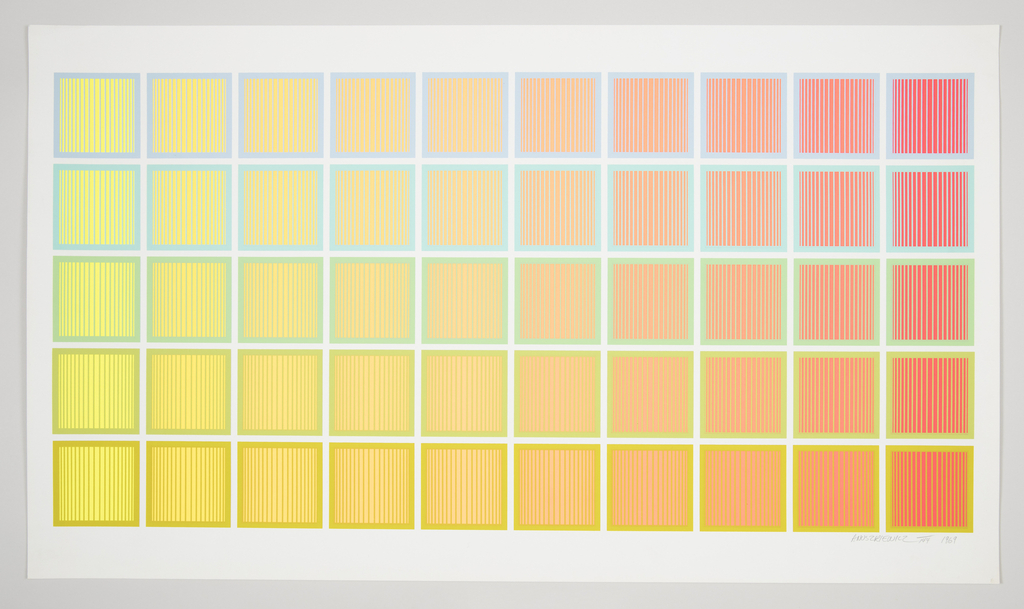There is one other image of this object. See our image rights statement.
Object Timeline
|
1969 |
|
|
1999 |
|
|
2015 |
|
|
2017 |
|
|
2018 |
|
|
2024 |
|
Print, League of Women Voters
This is a Print. It was designed by Richard Anuszkiewicz. It is dated 1969 and we acquired it in 1999. Its medium is screenprint on paper. It is a part of the Drawings, Prints, and Graphic Design department.
A clear understanding of optical effects characterizes the work of Richard Anuszkiewicz, a student of Josef Albers. In this design, each block of yellow, orange, or red is bordered with pale blue, green, or deep yellow, giving the illusion of a continuous gradation from cool and light in the upper left corner to warm and saturated in the lower right.
This object was
donated by
Mr. Joshua Mack.
It is credited Gift of Joshua Mack.
- Blanket, Index Collection, 2012
- organic cotton warp, merino wool weft.
- Gift of Raw Color.
- 2013-22-1
- Poster, Exhibition of Rokuro Taniuchi at Seibu Department Store
- screenprint on white wove paper.
- Gift of Sara and Marc Benda.
- 2009-12-14
- Poster, The wise man looks into space...
- lithograph and embossing on paper.
- Gift of Various Donors.
- 1981-29-15
Our curators have highlighted 8 objects that are related to this one. Here are three of them, selected at random:
- Calendar, August 1970, 1970
- lithograph on paper.
- Gift of Unknown Donor.
- n-d-1632
- Drawing, The Chromo Cube
- computer ink plotter print on paper.
- Gift of Beck & Jung.
- 1981-19-1
- Poster, Chrome Cube
- computer ink plotter print on paper.
- Gift of Holger Backstrom and Bo Ljundberg.
- 1985-9-1
Its dimensions are
57.2 × 99.9 cm (22 1/2 × 39 5/16 in.)
It is signed
Signed in graphite, lower right: ANUSKIEWICZ 144 1969
Cite this object as
Print, League of Women Voters; Designed by Richard Anuszkiewicz (American, b.1930); USA; screenprint on paper; 57.2 × 99.9 cm (22 1/2 × 39 5/16 in.); Gift of Joshua Mack; 1995-38-8
This object was previously on display as a part of the exhibition Saturated: The Allure and Science of Color.

![Blanket, Index Collection, 2012 A twill woven cotton and merino wool blanket with twenty-five horizontal bands of color which increase and descrease in saturation in small block increments from one side to the other. The colors include violet, olive green, pink, pale blue and lemon yellow. At the top of the blanket the words [RAW COLOR, MULTITONE, INDEX COLLECTION] are printed in violet capital letters](https://images.collection.cooperhewitt.org/90373_582628846e909e37_n.jpg)
![Poster, Exhibition of Rokuro Taniuchi at Seibu Department Store A screenprint on white wove paper poster with a fluroescent orange and red ombre portrait of the artist holding a cigarette set against a blue, green and yellow gradient background. In the lower left are Japanese characters printed in orange, and the word [SEIBU] is printed in white capitals inside a white box, with white Japanese characters underneath on our left corner of the portrait.](https://images.collection.cooperhewitt.org/267674_3afd04cb9ca43800_n.jpg)



